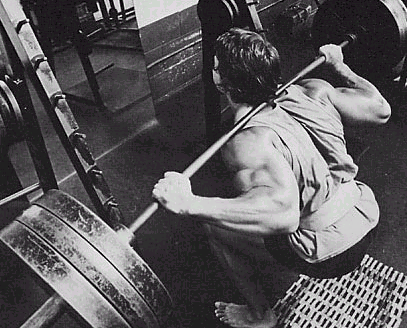Arnold Schwarzenegger’s physique is legendary, not just for its size but for its symmetry and proportion. His leg development was as critical as his famous upper body, providing a solid foundation that complemented his massive frame.
This guide dives into Arnold’s approach to leg workouts, which helped him secure seven Mr. Olympia titles.
An Overview of the Leg Muscles
The legs contain some of the largest and most powerful muscles in the body. It’s good to understand the basics of leg muscle anatomy before getting into intense workouts for the legs. So, some key leg muscle groups include:
- Quadriceps: Located at the front of the thigh, responsible for knee extension and critical in squats and lunges.
- Hamstrings: Running along the back of the thigh, these muscles play a significant role in knee flexion and hip extension.
- Glutes: Comprising the gluteus maximus, medius, and minimus, these muscles are involved in hip movement and stabilization.
- Calves: Made up of the gastrocnemius and soleus muscles, they are vital for movements involving the ankle and foot.
The Importance of Leg Training & Development
Arnold stressed the importance of strong legs for a balanced physique, highlighting their role in enhancing body symmetry and functional strength. He pointed out that in sports and bodybuilding, robust legs are crucial due to the thighs being some of the largest and most powerful muscles, contributing significantly to the overall mass and appearance of the physique.
Arnold also knew that well-proportioned legs are vital as they support not only the physical demands of heavy lifting and endurance but also ensure the upper body doesn’t overpower the lower body, maintaining aesthetic appeal similar to classical Greek sculptures.
He also emphasized the dedication required to develop the calves, suggesting that achieving substantial growth could take years of focused training.
How to Train Legs Properly
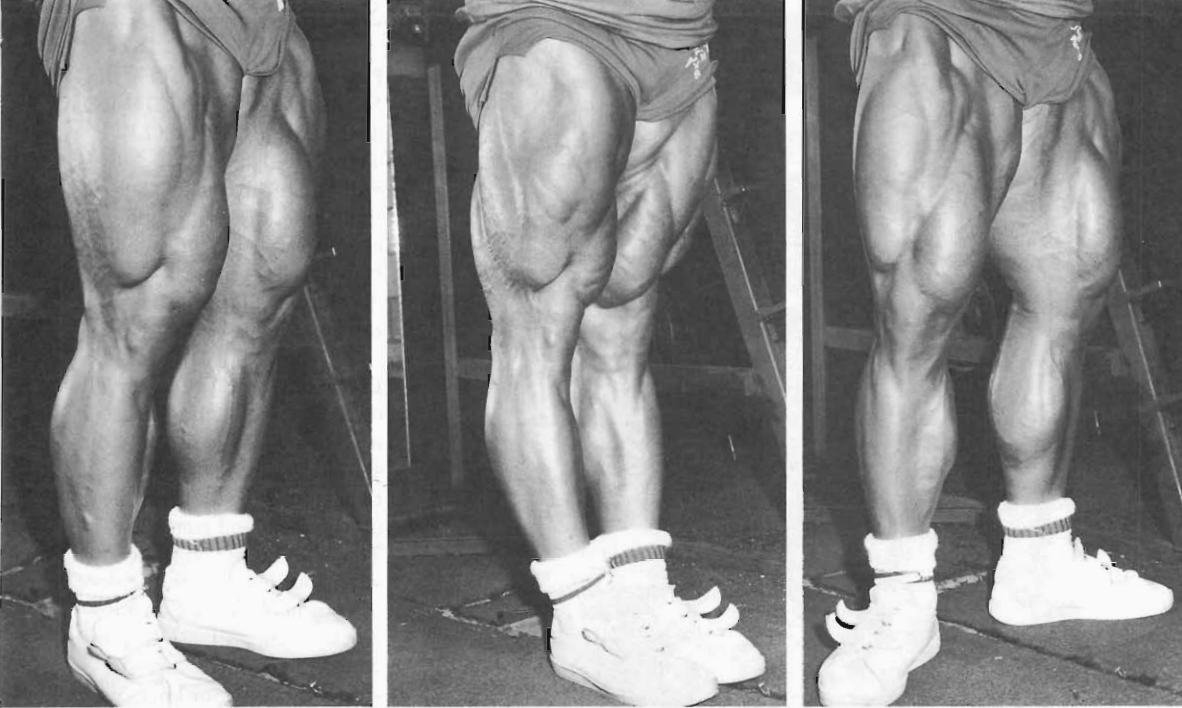
Training legs requires a combination of intensity, volume, and technique. Arnold emphasized the importance of varying exercises to target all aspects of the leg muscles, incorporating both compound movements for overall strength and isolation exercises for specific muscle development.
Thigh Training Demands
Leg training demands extreme effort due to the large size and power of the thigh muscles, which are essential in both sports and bodybuilding.
Arnold himself admitted to initially doing insufficient squat sets and not loading enough weight on the leg press. Upon increasing his workout intensity, he witnessed significant thigh growth, accepting that effective leg workouts must be exceptionally challenging.
He highlighted the importance of mental preparedness to tackle intimidating exercises like heavy squats and leg presses, essential for achieving substantial leg muscle development. Arnold stressed the necessity of pushing past comfort zones to achieve full leg development. He also advised on the importance of technique and proper execution in leg exercises to ensure maximum effectiveness of the training effort.
Building the Quads
Building strong quadriceps involves achieving mass, shape, and clear muscle separation, essential for competitive bodybuilding. To accomplish this, one must focus on developing overall thigh mass to balance the upper body, primarily through heavy weightlifting exercises like Squats and Leg Presses.
However, modern bodybuilders require more than just size; they need defined muscles with visible striations, a well-shaped sweep on the outer thigh, and distinct muscle separations. Squats are fundamental for mass building but may need to be supplemented with Front Squats to reduce lower back involvement and more directly target the quadriceps. Other exercises such as Heavy Leg Presses and Leg Extensions are also great for both mass building and muscle definition.
The Hamstrings, or “Leg Biceps” as Arnold Calls Them
The leg biceps, or hamstrings, gained significant importance in bodybuilding during Arnold’s time, showcased by athletes like Tom Platz, Sergio Oliva, and Robby Robinson. Previously underemphasized, well-defined hamstrings are crucial for a balanced physique in competition. Recent trends show a marked increase in the striation and vascularity of the hamstrings, setting a new standard in bodybuilding aesthetics.
For optimal development, the primary exercises for the hamstrings are Leg Curls, performed either lying or standing to isolate each leg. However, they are also engaged during Squats and Lunges, particularly through the lower movement range. Exercises like Straight-Leg Deadlifts and Good Mornings, traditionally part of lower back training, are also effective in stretching and strengthening the leg biceps.
Detailed Breakdown of Arnold’s Leg Workout
Arnold’s leg workouts were as intense as they were strategic, often including the following exercises:
1. Barbell Squat

- Purpose and Benefits: Barbell Squats are essential for building overall leg mass, targeting the quadriceps, hamstrings, and glutes. They also engage the lower back and core, making them a foundational exercise for both strength and size.
- How to Do It:
- Start by positioning a barbell on a squat rack at chest level.
- Duck under the bar, placing it across the back of your shoulders slightly below the neck.
- Grip the bar on both sides, lifting it off the rack by straightening your legs and stepping back.
- Stand with your feet shoulder-width apart, toes slightly pointed out.
- Lower your body by bending your knees and hips, keeping your back straight and chest up.
- Descend until your thighs are at least parallel to the floor.
- Push through your heels to return to the starting position.
Sets/Reps: 5 sets of 8-12 reps
2. Leg Press
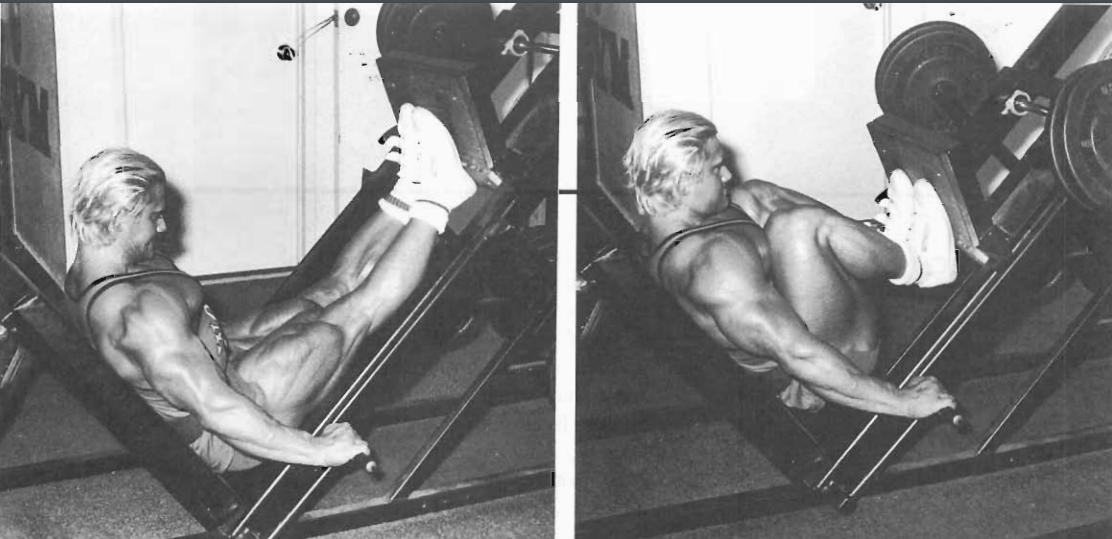
- Purpose and Benefits: The Leg Press machine allows you to target the quadriceps, hamstrings, and glutes with less strain on the back. It’s excellent for building leg mass and strength.
- How to Do It:
- Sit down in a leg press machine with your back against the padded support.
- Place your feet on the platform shoulder-width apart.
- Lower the safety bars holding the weighted platform and press the platform all the way up until your legs are fully extended but not locked.
- Lower the platform by bending your knees and keep going until your upper and lower legs create a 90-degree angle.
- Press the platform back to the starting position.
Sets/Reps: 4-5 sets of 10-12 reps
3. Leg Extension

- Purpose and Benefits: Leg Extensions focus solely on the quadriceps. They are used for defining and isolating the front thigh muscles and are typically used as a finishing exercise to enhance muscle definition.
- How to Do It:
- Sit on a leg extension machine with your legs under the pad, feet pointed forward.
- Adjust the pad so it falls on top of your lower legs, just above your feet.
- Ensure your legs form a 90-degree angle between the lower and upper leg.
- Using your quadriceps, extend your legs to the maximum as you exhale.
- After a brief pause at the top, lower the weight back to the original position.
Sets/Reps: 6 sets of 12-15 reps
4. Lying Leg Curls
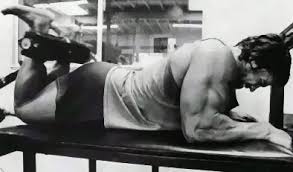
- Purpose and Benefits: Lying Leg Curls specifically target the hamstring muscles at the back of the thigh. They are crucial for balanced thigh development and knee stability.
- How to Do It:
- Lie face down on a leg curl machine with the pad of the lever on the back of your legs just below the calves.
- Ensure that your legs are fully stretched.
- Curl your legs up as far as possible without lifting your upper legs from the pad.
- Hold the contracted position for a moment, then bring the legs back to the starting position.
Sets/Reps:6 sets of 10-12 reps
5. Barbell Lunges
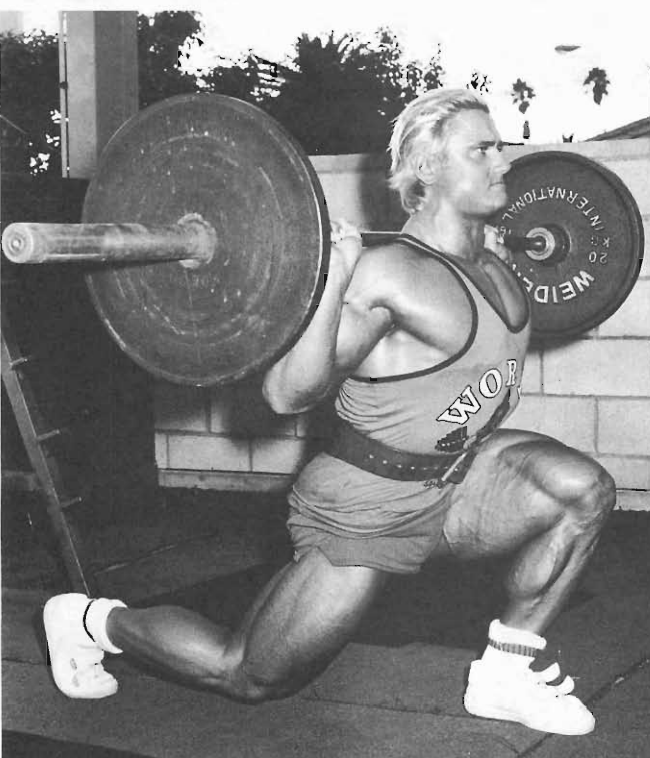
- Purpose and Benefits: Barbell Lunges are excellent for developing the thighs and glutes while also improving balance and coordination. They target each leg individually, helping to correct muscle imbalances.
- How to Do It:
- Stand upright with a barbell across your upper back.
- Step forward with one leg, lowering your hips until both knees are bent at about a 90-degree angle.
- Make sure your front knee is directly above your ankle and your back knee doesn’t touch the floor.
- Push off with your front leg to return to the starting position.
- Repeat on the opposite leg.
Sets/Reps: 4 sets of 15 reps per leg
How Arnold Trained Calves
Arnold noted that calves, being difficult to develop, require training from various angles with extremely heavy weights, akin to their everyday use in walking and running which involves various foot and ankle movements.
Arnold didn’t train calves with the rest of his legs, but rather recommended daily sessions lasting 30 to 45 minutes and utilizing all high-intensity training principles to shock the calves into growth.
Arnold learned from Reg Park that normal weights weren’t sufficient as each calf is already accustomed to bearing his body weight; hence, using heavier weights is essential for growth.
He suggested that the primary exercises for building mass in the calves are Standing Calf Raises and Donkey Calf Raises, which target both major muscles in the calves—the gastrocnemius and soleus.
Seated Calf Raises

- Purpose and Benefits: Seated Calf Raises target the soleus muscle in the calves. This exercise is key for comprehensive calf development and endurance.
- How to Do It:
- Sit on a calf raise machine, placing your thighs under the pad and balls of your feet on the platform.
- Lower your heels to stretch the calves and then lift your heels as high as possible, squeezing at the top.
- Pause at the top before returning to the starting position.
Sets/Reps: 8 sets of 15-20 reps
Donkey Calf Raises
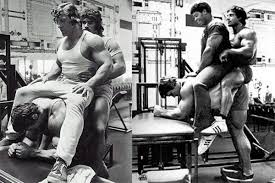
- Purpose and Benefits: Donkey Calf Raises emphasize the gastrocnemius and soleus muscles in the calves. The position allows for a greater range of motion and intense peak contraction.
- How to Do It:
- Bend forward at the waist and support your upper body on a bench or similar surface.
- Have a partner add weight by sitting on your lower back or use a machine specifically designed for this exercise.
- Perform calf raises by lifting your heels as high as possible and squeezing the calves.
- Lower your heels below your toes for a deep stretch before repeating.
Sets/Reps: 4-5 sets of 10-15 reps
Other Leg Exercises Arnold Recommends:
Feel free to mix in any of the following exercises, as these are all discussed by Arnold in his encyclopedia for modern bodybuilding for their own respective reasons.
- For Quads: Machine Squats, Half Squats, Front Squats, Sissy Squats, Hack Squats,
- For Hamstrings: Standing Leg Curls, Straight Leg Deadlifts,
- For Calves: Leg Press Calf Raises, One-Legged Dumbbell Calf Raises, Standing Calf Raises
Arnold’s Different Leg Programs
Beginning Program
For beginners, Arnold emphasizes foundational exercises such as Squats, Lunges, and Leg Curls, which are crucial for building the initial size and strength of the thighs and calves. In this phase, the goal is to develop a balanced strength curve, enhancing the muscle’s ability to perform at both full contraction and extension. Beginners are advised to focus on achieving full range of motion in Calf Raises and to integrate these movements three times a week, gradually adapting to the stress of weight training.
Advanced Program
As trainees progress, the routine becomes more demanding with the inclusion of variations like Front Squats and Hack Squats, which target specific areas of the thighs for enhanced separation and muscle detail. Advanced training also introduces increased frequency, recommending calf workouts six times a week using a variety of exercises such as Donkey Calf Raises and Seated Calf Raises to further develop the soleus and gastrocnemius muscles.
Competition Program
For competitors, leg training intensifies to focus on muscle definition, separation, and overall symmetry. This program involves strategic supersetting, such as combining Squats with Leg Extensions, to challenge the legs to their limits. This stage emphasizes the use of varied foot positions and techniques to refine all aspects of leg aesthetics, ensuring that each muscle group is fully developed and visually striking. Techniques are tailored to maximize the muscular detail required for competition, including a high volume of sets and integrating calf-specific exercises to enhance lower leg development.
Additional Tips From Arnold for Leg Training
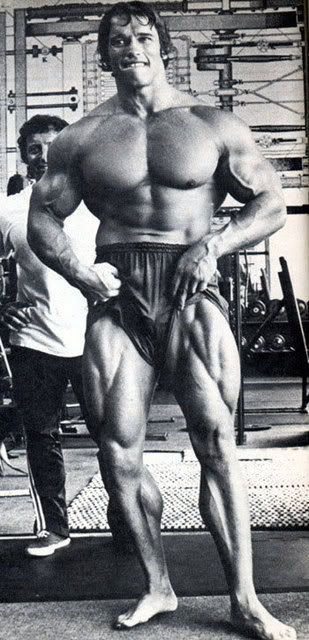
Stretching and Flexing
Arnold emphasizes the importance of both flexing and stretching in leg training to achieve peak muscle development and endurance. Flexing during workouts enhances muscle separation and the visibility of cross-striations, which are crucial for modern bodybuilding standards.
However, because intense contraction of the large leg muscles can cause them to shorten, stretching is equally vital. Champions like Tom Platz dedicate significant time to stretching both before and after workouts to maintain muscle elasticity and development.
Weak Point Training
Quads/Hamstrings
He also highlights the necessity of addressing weak points in leg training due to the complexity and size of the leg muscles. He recommends prioritizing leg workouts when energy levels are highest, utilizing a supportive workout partner for encouragement and safety. Specific exercises are advised for targeted development:
- Lower Thigh Development: Emphasize the lower thigh by performing Squats, Hack Squats, and Leg Presses with a three-quarter movement—going all the way down but only coming up about three-quarters of the way. Leg Extensions should also be included, focusing on full extension to maximize lower thigh engagement.
- Outer and Inner Thigh Development: For the outer thighs, exercises like close-stance Squats or Leg Presses with toes pointed straight are beneficial. For the inner thighs, wider stance movements with toes pointed out or lots of Lunges are effective.
- Front Sweep of Thighs and Split Between Thighs and Leg Biceps: Front Squats and specialized Hack Squats that involve bringing the rear end forward as you rise can enhance the separation between the front and back of the upper leg.
Calves
Arnold stresses the importance of targeted training to address any disproportional development in the calves, similar to training other body parts. To enhance specific areas of the calves:
- Lower calves: Focus on Seated Calf Raises to develop the soleus muscle for a pronounced “V” look extending to the Achilles tendon. Also, slightly bend the knees during Standing Calf Raises and incorporate partial movements to intensify the workout at the bottom range.
- Upper calves: Emphasize the top part of the range during Standing Calf Raises, holding the peak contraction to enhance the upper calves. Utilize Calf Raises on the Leg Press and heavy Donkey Calf Raises for deep development.
- Inside and outside of the calves: Adjust the foot positions during Calf Raises—turning toes outward targets the inside, while turning them inward focuses on the outside calves.
- Uneven calf size: Perform additional sets for the smaller calf using one-legged variations of standard calf exercises to balance size.
- Front of the calves: Develop the tibialis anterior with Front Calf Raises to improve the frontal appearance and width of the calves, enhancing overall aesthetic appeal.
Final Tips
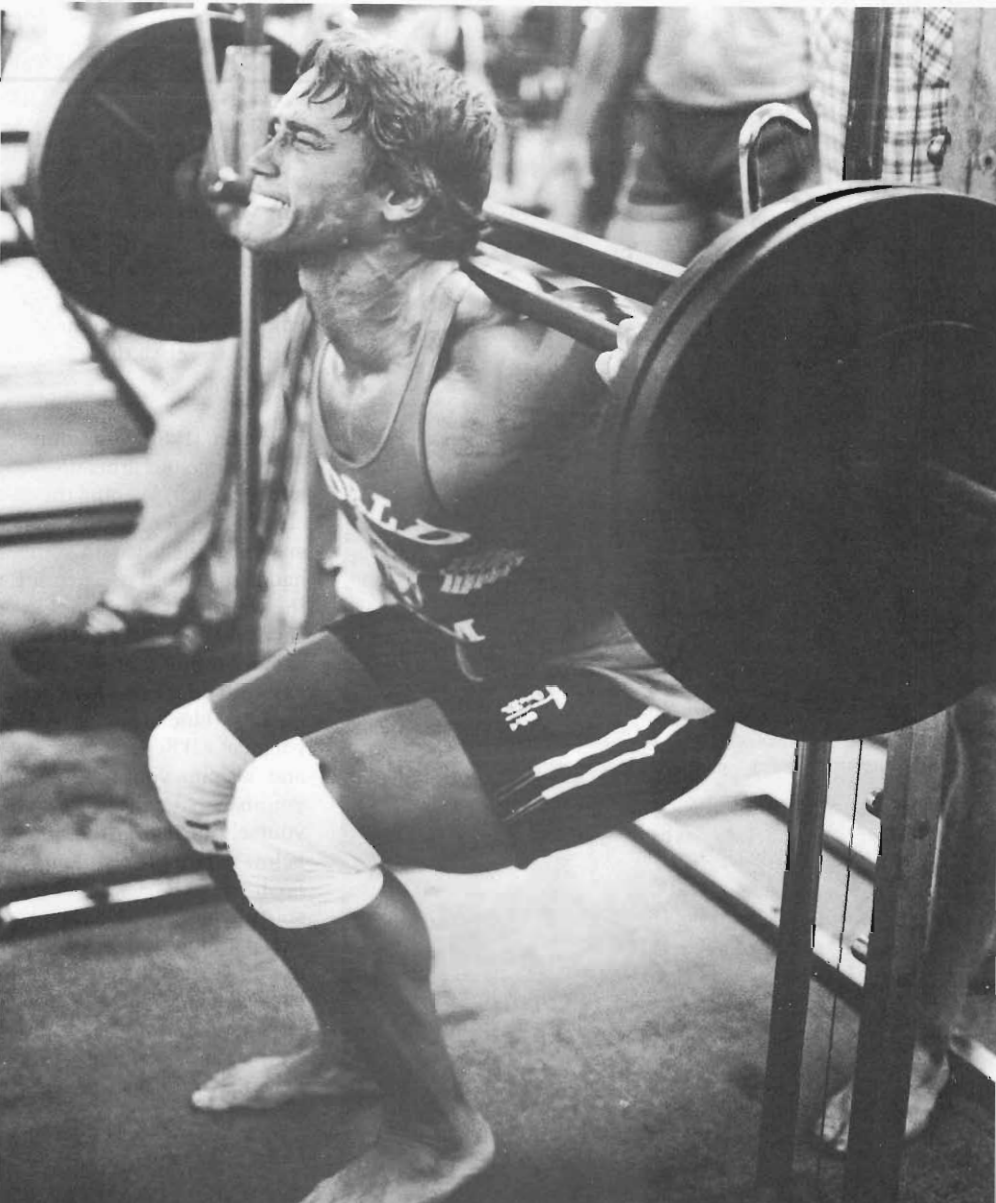
Arnold also shared a personal anecdote to highlight the psychological aspect of calf training. By cutting his pants to expose his calves, he forced himself to confront and improve his calf development.
He recommends employing the Priority Principle, starting workouts with calf training when energy levels are highest, to overcome weak calf development. Additionally, incorporating everyday actions like walking on toes or in sand can further enhance calf training outside the gym.
Arnold also suggests adjusting foot positions during Squat and Leg Press movements to isolate different parts of the thigh—normal width for overall development, close together for the outer thighs, and wide apart with toes outward for the inner and front thigh areas. This strategic variation in training helps overcome weak points and achieve balanced leg development.
Conclusion
Arnold Schwarzenegger’s approach to leg training offers valuable lessons for anyone looking to improve their lower body strength and aesthetics.
By adopting his techniques of intensity, variation, and focus, you can build a solid foundation of power and symmetry. Just as Arnold dominated the bodybuilding world with his impressive legs, you too can elevate your physique by integrating these strategies into your routine. Remember, every day is leg day in the pursuit of a championship-caliber physique.
To learn more about how to train like Arnold, read our articles on Arnold’s back workout, chest workout, arm workout, and shoulder workout.
References
- Schwarzenegger, Arnold, and Bill Dobbins. The New Encyclopedia of Modern Bodybuilding. Simon & Schuster, 1998.
- Gaines, Charles, and George Butler, directors. Pumping Iron. White Mountain Films, 1977.

